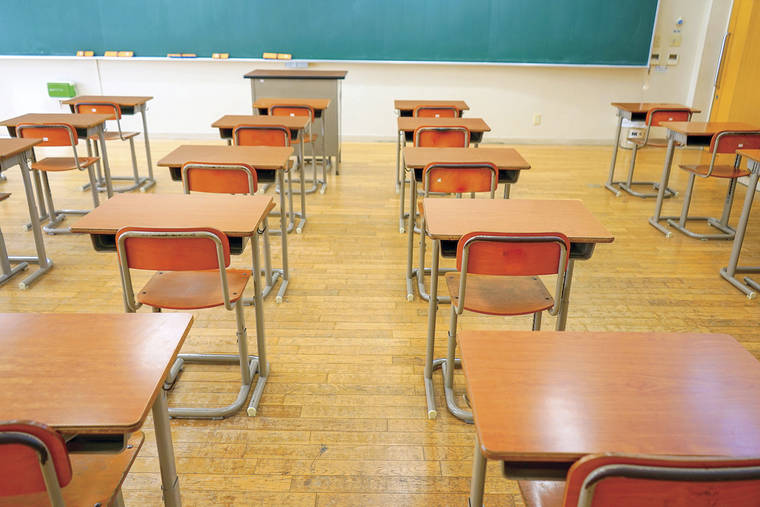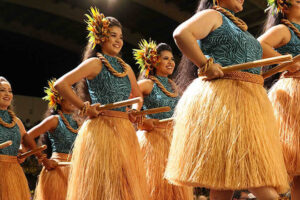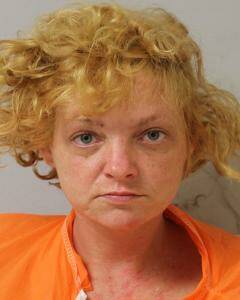With less than a month before students return to class, Hawaii’s public schools have made decisions about how to deliver instruction amid the ongoing COVID-19 pandemic.
Individual schools have selected from a variety of learning models outlined in the state Department of Education’s reopening plan, which was announced earlier this month.
Elementary schools could opt for face-to-face learning, which calls for all students to be on campus full-time each day for face-to-face instruction; a blended rotation, meaning one group of students will be present on campus receiving face-to-face instruction, while the other group participates in distance learning; and a hybrid model, where lower elementary and vulnerable students will have daily in-person instruction, while upper elementary students will use a blended rotation model.
In addition to face-to-face learning, middle schools could choose from an A/B two-day rotation, which combines face-to-face learning with online instruction, where groups of students (“A” and “B”) each report to the school twice a week; and combination rotation learning, which is similar to the two-day model, but schools determine the number of days students report to campus for face-to-face learning.
Hawaii’s high schools chose between the face-to-face and two-day rotation models, as well as a hybrid model, which calls for some students to be on campus for face-to-face instruction while others participate in distance learning. The most vulnerable students will be on campus daily for in-person learning.
“I think it’s a very dynamic and fluid situation,” Ka‘u-Keaau-Pahoa Complex Area Superintendent Chad Keone Farias said Friday.
Appreciative of the principals, faculty and staff who have worked hard to get plans in place, Farias said there’s still much work ahead.
His concern, however, is equity of access for students in rural areas who have limited access to internet or cellular service, who are also often the furthest from school.
Hilo-Waiakea Complex Area Superintendent Esther Kanehailua said safety and looking at what could be done given the physical space on campuses were the first considerations for school leaders.
“That’s kind of the challenge,” she said. “They want to bring back as many kids as possible, but it really comes down to if you have the space on campus to be able to do that safely.”
Space is a concern for many school administrators.
Hilo High School will operate under a hybrid model, which Principal Jasmine Urasaki said will give educators the flexibility to successfully offer students more learning options and maintain social distancing requirements.
Classroom sizes and social distance practices limit the amount of students able to be on campus or in a classroom at a time, she said.
While specific details are still being worked out, Urasaki said the hope is to operate on an A/B schedule, meaning two groups of students each attend two days a week, with virtual learning on one day. Students may also opt to do online learning only.
“There are a lot of concerns,” she said. “… We just want to make sure everybody will be safe, want to make sure students get the education they deserve and still get that high school life that’s (being) robbed from them right now. (We are) trying the best we can.”
Honokaa High and Intermediate decided on the two-day rotation due to social distancing guidelines.
Principal Rachelle Matsumura said all the Hamakua schools will be using an A/B rotation for students.
“We want to make sure that families are on the same rotation as they come all the way from Waimea and Paauilo for high school,” she said.
She’s concerned about employee safety and has been working to ensure the school has necessary personal protective equipment for employees, and that employees are ready for students to return.
“We know this isn’t the ideal school opening, but definitely making sure that it will be a safe opening,” Matsumura said.
But even as plans are made in a dynamic and constantly evolving situation, some have already changed.
Waiakea High School had initially chosen to offer a two-day rotation model, but principal Kelcy Koga said Friday that administrators were in the process of reconsidering other options.
The initial choice was based on having a 3-foot distance between students, but Koga said the school is erring on the side of safety and moving to have a 6-foot radius between students.
In its guidance for reopening schools, the state Department of Health recommended a distance of at least 3 feet between seats and at least 6 feet of distance if students are facing each other.
The Hawaii State Teachers Association has said allowing students to be 3 feet apart puts students and staff in danger, and thousands of pages of testimony were submitted before a meeting Thursday of the state Board of Education, in which numerous parents and teachers expressed concern, anger and frustration about the 3-foot social distance guideline and urged the BOE to consider a 6-foot distancing requirement.
Koga said letters were sent to parents Friday, and he hopes to have another instructional model and schedule selected next week.
Waiakea also is trying to align its plans with its feeder schools and Hilo High, he said.
“Having all those parameters, it kind of limits us in the options we have.”
But with 1,300 students and fewer than 100 classrooms, Koga said social distancing means the school can’t have all students all day every day. Even having half of the students coming every other day won’t be possible with social distancing, he said.
Although the school will be ready for the start of the academic year, Koga said there are “a million concerns,” including the possibility that someone might get infected, making sure everything is cleaned and sanitized, as well as coming up with a schedule and meeting the minimum requirement of 180 days of instruction.
“I think every school is trying to come up with their learning model (and) instructional (method) that benefits and keeps everybody safe. … It’s going to be a different school year, and we’ve just got to be patient and vigilant.”
Email Stephanie Salmons at ssalmons@hawaiitribune-herald.com.
Learning models selected for each Big Island school
Hilo-Waiakea Complex Area
De Silva Elementary, Haaheo Elementary, Hilo Union Elementary, Kapiolani Elementary, Kaumana Elementary, Keaukaha Elementary, Waiakea Elementary and Waiakeawaena Elementary schools adopted a blended model.
Hilo Intermediate and Waiakea Intermediate schools will implement the two-day rotation model.
Hilo High School will use a hybrid model.
Kalanianaole Elementary and Intermediate will use the blended model for its elementary students and the two-day rotation for others.
Ka‘u-Keaau-Pahoa Complex Area
Keaau Elementary, Keonepoko Elementary, Mountain View Elementary and Pahoa Elementary will follow the blended models, while Ma Wai Ola Public Charter School and Naalehu Elementary have selected a hybrid model.
Keaau Middle School will use a combination rotation and Keaau High School will implement the two-day rotation model.
Ka‘u High and Pahala Elementary will use a hybrid model for its elementary and high school students and a combination rotation for intermediate students while Pahoa High and Intermediate will use a combination rotation for its intermediate and hybrid model for its high school students.
Honokaa-Kealakehe-Kohala-Konawaena Complex Area
Holualoa Elementary, Honaunau Elementary, Honokaa Elementary, Hookena Elementary, Kahakai Elementary, Kealakehe Elementary, Kohala Elementary, Konawaena Elementary, and Waimea Elementary schools will implement blended models.
Kealakehe Intermediate, Kohala Middle, Konawaena Middle, Kealakehe High High, Kohala High, Konawaena High will use the A/B two-day rotation.
Honokaa High and Intermediate, Ke Kula O Ehunuikaimalino, Paauilo Elementary and Intermediate and Waikoloa Elementary also will use A/B two-day rotation for middle grades and blended models for their elementary students.






